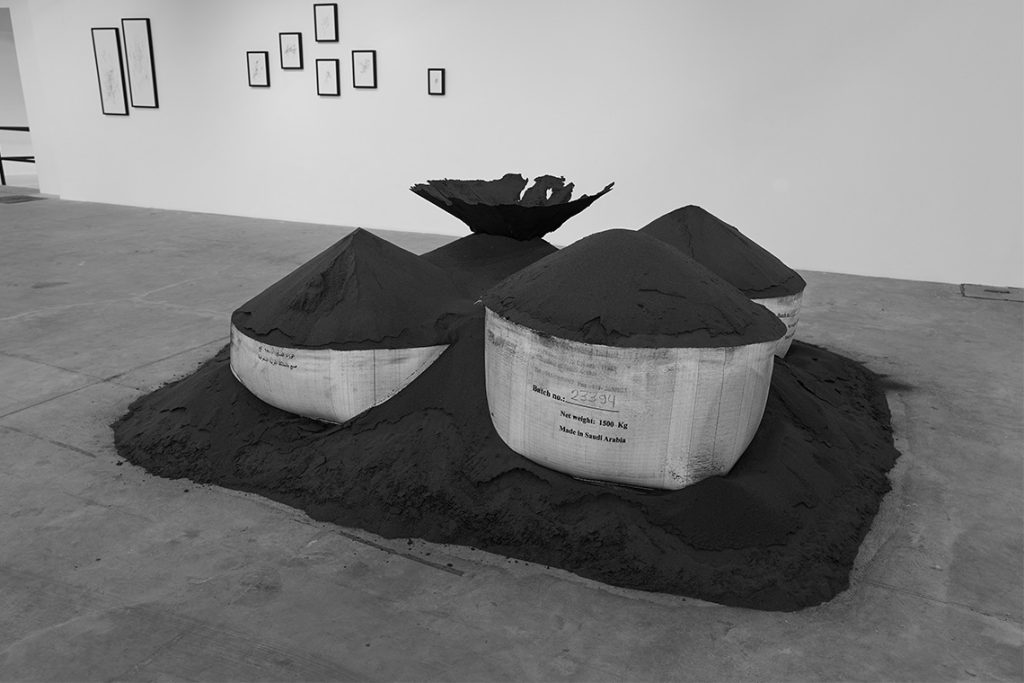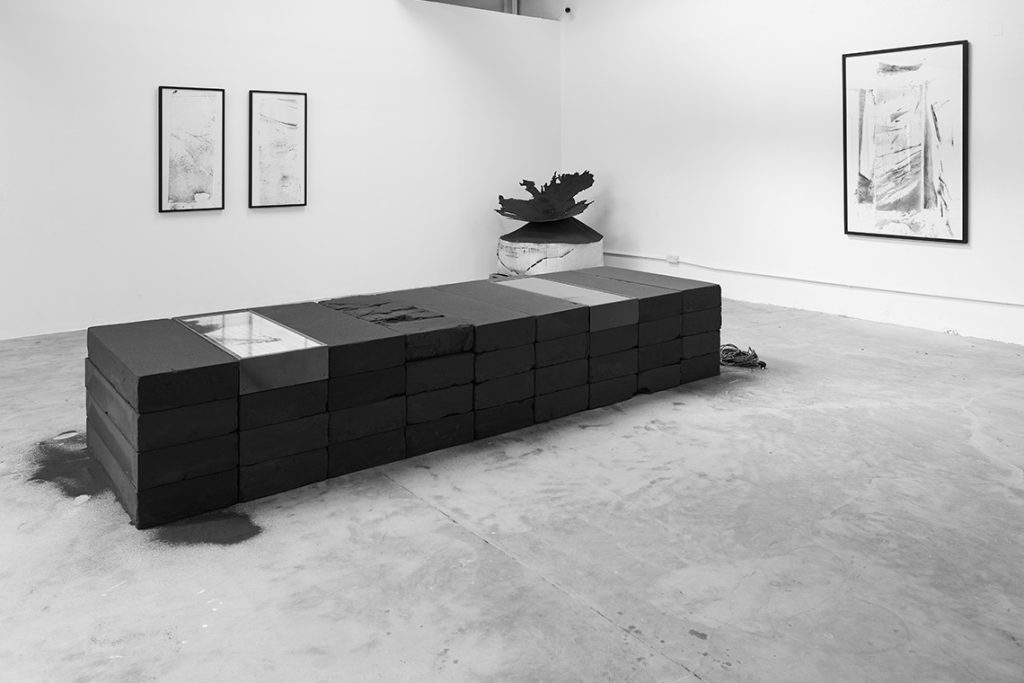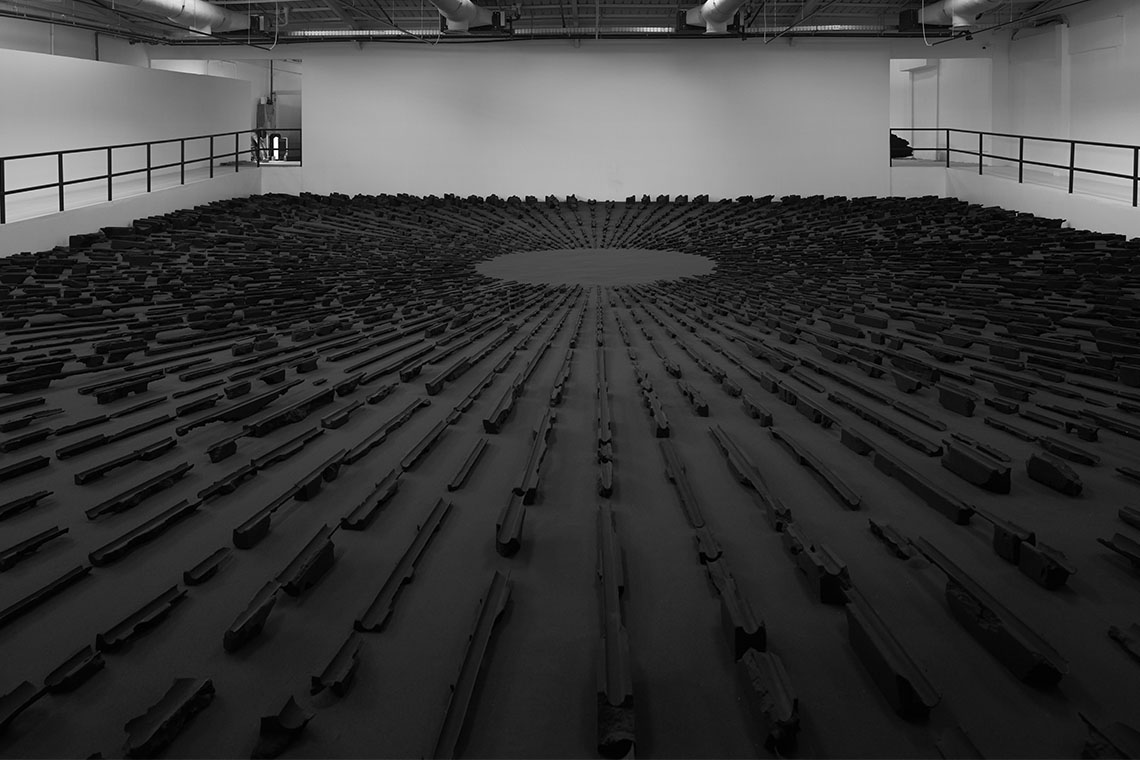In his latest solo show, The Ground Day Breaks, Muhannad Shono went micro as he honed down on the minutiae of our environment and revealed a landscape of bewildering scale.
“To see a world in a grain of sand and heaven in a wild flower,” poet and painter William Blake once wrote, suggesting that profound meaning can be perceived in the most mundane things. In this particular story, a grain of sand was all it took to imagine a world of potential. As one of the Kingdom’s most daring voices, Muhannad Shono centred reclaimed black foundry sand in his recent solo exhibition, The Ground Day Breaks, hosted by ATHR Gallery (18 February–20 May), and allowed us to follow along as these castaway granules recovered their narrative.
In the heart of Riyadh’s ever-so-vibrant JAX, the Saudi capital’s emerging art district, the monochromatic gallery seemed almost flat in contrast, surrounded by vivid murals and enticing activations. But in typical Shono fashion, what we saw was almost never simply what we got.
Foundry sand, or moulding sand was mixed, bonded, crushed, heated and manipulated to become a mould for metal castings. Its sole purpose was to shape others, and in this show, curated by Dr Nat Muller, it took a rite of passage to reinvent its own form.
In our journey across the gallery, we began with a breaking point. Blocks seemed to have broken. We could document the very topography of their destruction as they created a landscape of sand dunes through their imprint on carbon paper. We only saw the outline of the blocks, but no grains are present. They were, in fact, already one step ahead. What Remains (2024) confirmed that blocks of sand broke on the floor and perhaps gained mobility and fluidity as the grains began to shape themselves on a hard surface, reminding us that the elements are intrinsically regenerative by nature.
We were met with daybreak in Night Dew (2024), a series of lightboxes recalling memories of the grain stippled on carbon paper. The delicate works exude a ghostly but dreamlike state, almost like night stars speckled on a dark sky, but here the subject is transient. It imagines a world in which they may have been beautiful, encapsulating their folkloric presence between the darkness of the stippled dots and the beam that frames them. Without the illumination, their potential remains unseen; without their marks/impact (athar), the light is void. Perhaps, without day, the ground never breaks. They may only exist between light and dark, making this symbiotic nature a spectacle of discovery.

Photography by Artur Weber. Image courtesy of the artist and ATHR Gallery
In the work’s twin, Seedlings (2024), the piece sprouts from its latest form into a determined floral bloom onto paper. The use of horticultural terminology to introduce the works suggest a willful intent to remind us of the origin story; without soil, nothing can become. Shono uses a stippling method on carbon paper to hollow out its imprints, almost as if planting the seed onto the canvas beneath. While Night Dew suggests a possibility of something new, Seedlings permeates its genesis.
We flowed through the exhibition in a storyline, where From the Land (2024) suggested a preamble of robust movement stemming from the earth, perhaps a nod to Al-Khidr, or the Green One, a character found in Islamic narratives and evident in Shono’s past work. His 2020 piece, The Last Garden of Al-Khidr, tells the story of those who choose to reclaim their imaginative spirit and refuse to be silenced. Similarly, the sand grains rise up in their own distinct nature, almost reaching upwards or becoming a nestle waiting to receive. The pieces are made by coating bodies of sand with sprayable resin, and peeled once the layers are hardened. Although sprouting from the ground, they seem brittle and otherworldly.
The lore possibly continued in Folding Lines (2024),as the pieces demonstrate the malleability and shapeshifting qualities of our protagonist. Large strips of congealed sand rained down from the ceiling like curtains. The piece was strategically placed closest to the gallery’s entrance, as if hinting at us upon arrival of its aspirational nature. From only a grain, it grew to the highest heights.

Photography by Artur Weber. Image courtesy of the artist and ATHR Gallery
The anthology of works concluded with The Ground Day Breaks (2024), a marvellous collection of 2000 hand-crafted pieces radiating outwardly from an empty circular centre. The large-scale site-specific work engulfed the entirety of the gallery’s backroom, as if a secret garden awaiting discovery. Yet the garden was bare, and we were left to contemplate only the skeletons of the irrigation system underneath its surface. It then became clear that the motion is cyclical: the desert is both a graveyard and birthsite. Simultaneously contradictory but true, as the arid land is a canvas for our protagonist, it is also a lifesource for our modern world, yielding the concrete that builds our homes and the light bulbs that illuminate them.
All this, in a miniscule grain of sand. “I made a choice from a young age to wield the line to create and not to decapitate,” Shono has said. In this solo show he presented a story about agency, renewal and tension, in which one of the most microscopic elements, one that we pass off as insignificant, became larger than life. Therein lies the truth of the very ground that our daylight reveals.



